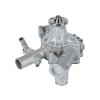A difference-in-conditions insurance policy provides coverage for types of damage that a basic policy doesn't. Difference-in-conditions insurance is available for various types of property insurance policies, including homeowner's insurance, truck insurance and ship insurance. A customer who purchases a difference-in-conditions policy still must purchase a basic insurance policy.
History
The original difference-in-conditions policies provided coverage for any type of risk that a standard property insurance policy didn't include, so they were first known as “all risk” policies, according to Ohio State University. A modern difference-in-conditions policy may list the specific types of disasters for which it provides coverage and may exclude other damages from reimbursement. Policies that do cover all risks that the basic policy doesn't cover are still available, although they're more expensive.
Exclusions
Because the standard insurance policy in each industry is different, the exclusions from the named insurance policy are also different. A marine insurance cargo policy covers damage from stranding, sinking, ship collisions and jettisoning cargo. A commercial building policy includes coverage for fire, wind, theft and other common sources of structural damage.
Extra Damage
A difference-in-conditions insurance policy may also reimburse additional expenses greater than the limit established in the standard insurance policy. According to Ohio State University, this type of policy is also known as a difference-in-limits policy. For example, if a standard policy reimburses $1 million of flooding damage, the difference-in-conditions policy may provide an additional $5 million of coverage.
International Trade
Difference-in-conditions insurance is useful for international corporations. The standard policy in one country may not provide coverage for a type of disaster in which the corporation would be liable in another country for reimbursing property damage. The nation may require the corporation to purchase insurance from a domestic firm that doesn't provide this necessary coverage. An international difference-in-conditions policy can cover the gaps in coverage in the policies available in each country.
Secondary Coverage
A difference-in-conditions policy may also help a company that has an unreliable primary insurance company. According to a 2009 report on the Harvard Law School Forum on Corporate Governance and Financial Regulation, a difference-in-conditions policy may include a dropdown clause, which requires the secondary insurer to reimburse any claim that the primary insurer doesn't reimburse. This clause requires the difference-in-conditions insurance policy issuer to pay a claim for a standard industry risk that it wouldn't normally pay.






